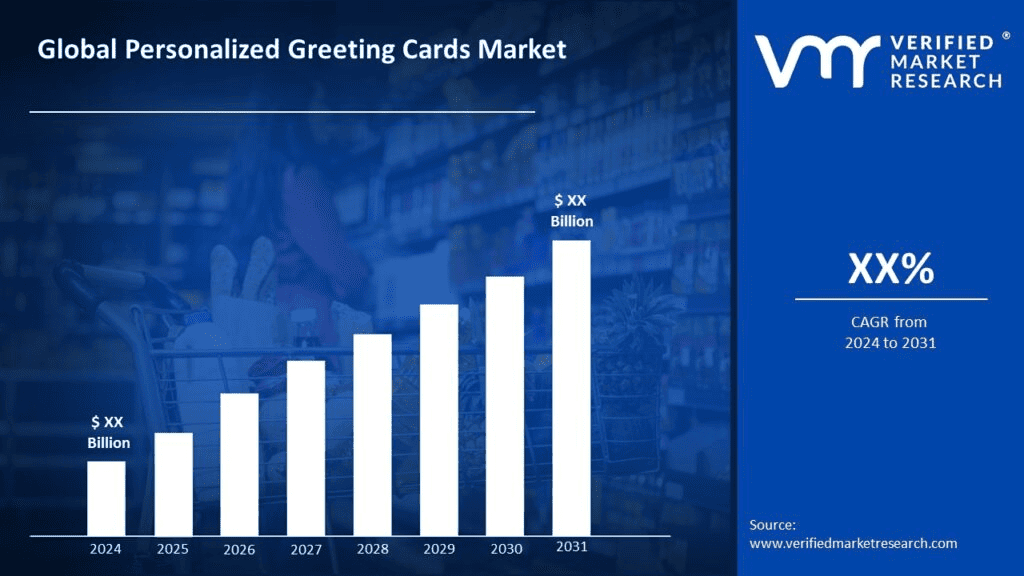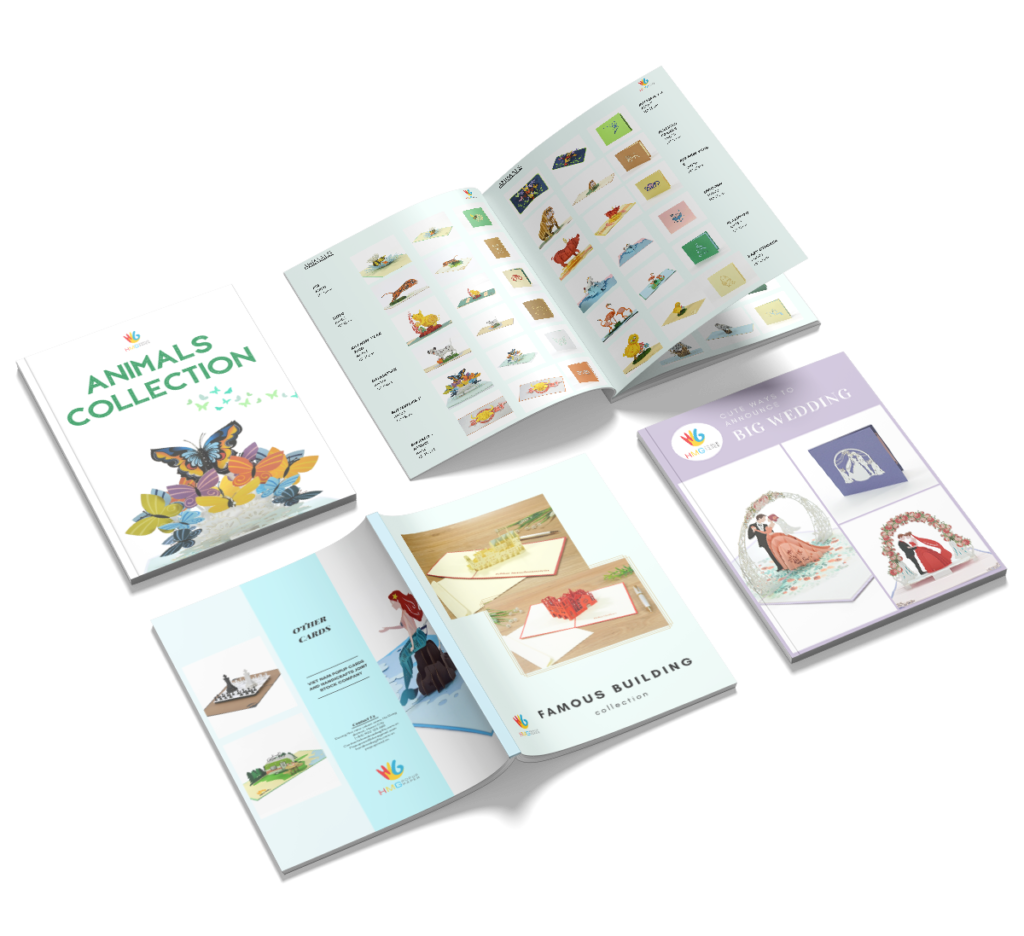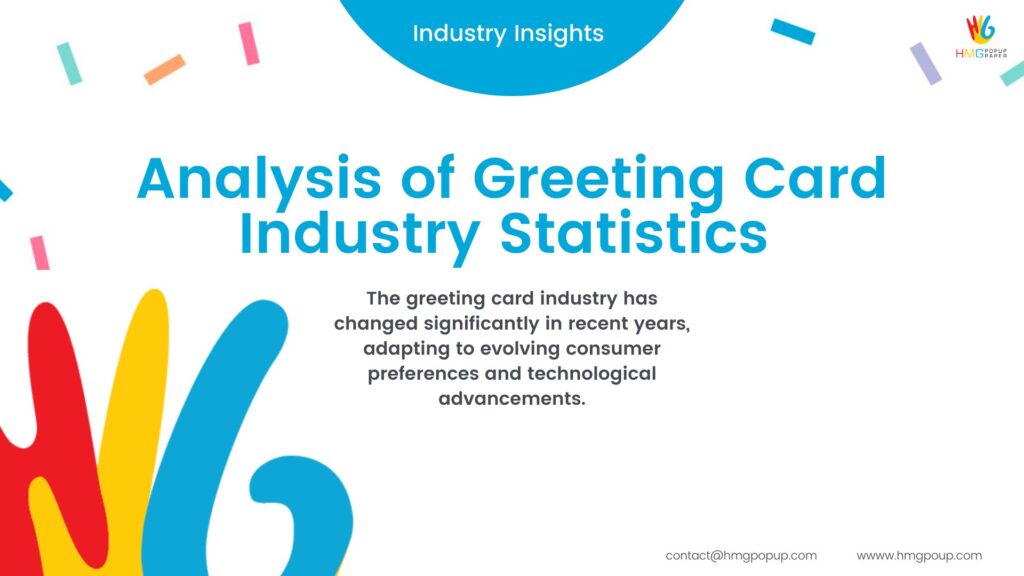The greeting card industry has changed significantly in recent years, adapting to evolving consumer preferences and technological advancements. In this article, HMG Pop Up Paper will delve into the key market trends and consumer behavior shaping the future of the greeting card industry.
1. Personalization and Customization
Consumers are increasingly seeking greeting cards that resonate on a personal level. A study by Shutterfly revealed that 54% of American consumers still prefer mailing traditional paper greeting cards, valuing the sentimental touch that comes with a physical card. This preference underscores the importance of personalization, as customized cards allow senders to convey their feelings more authentically.

Global Personalized Greeting Cards Market
The market for personalized greeting cards is projected to grow significantly, with forecasts indicating a robust increase in demand from 2024 to 2031. Factors driving this growth include the rising adoption of personal messages and innovative product offerings, such as LED light cards and 3D pop up printed designs.
According to market analysis, the global personalized greeting cards market is expected to witness substantial growth, driven by increasing disposable income and a growing population. The ability to customize cards with personal messages, photos, or unique designs makes them more appealing, particularly for special occasions such as weddings, birthdays, and holidays.
2. Seasonal and Everyday Occasions
The greeting card industry has long been associated with specific occasions, and while birthdays remain the most popular reason for sending cards, there is a noticeable shift towards recognizing a broader range of events and sentiments. This section provides an in-depth look at the significance of seasonal and everyday occasions in the greeting card market, supported by relevant statistics.
2.1. Dominance of Birthday Cards
Birthdays continue to dominate the greeting card market, with over 7 billion birthday cards sold annually in the U.S., accounting for more than 50% of all greeting cards purchased. This statistic highlights the cultural importance of celebrating birthdays and the role that greeting cards play in these celebrations. The Greeting Card Association notes that birthday cards are not only a staple in card-giving but also serve as a means of expressing affection and personal connection.
Explore more: 4 Newest Wholesale 3D Pop Up Birthday Greeting Cards In Bulk
2.2. Growing Popularity of Non-Traditional Occasions
In recent years, there has been a marked increase in the popularity of greeting cards for non-traditional occasions. These include:
- New Job Promotions: Cards celebrating career advancements are becoming more common, reflecting a cultural shift towards recognizing professional milestones.
- Graduations: With 59 million graduation cards sold annually, this occasion has become a significant market segment, as families and friends seek to commemorate educational achievements.
- Just Because Cards: The rise of “thinking of you” cards illustrates a growing desire to connect with loved ones outside of traditional holidays. This trend indicates that consumers are looking for ways to express care and appreciation without a specific occasion.
- Life Milestones: Cards for events such as weddings, retirements, and new home celebrations are increasingly popular. These cards allow senders to convey heartfelt congratulations and support during significant life changes.
2.3. Seasonal Card Sales
While birthdays lead in card sales, seasonal occasions also contribute significantly to the market. For example:
- Christmas: Approximately 1.3 billion Christmas cards are sold each year in the U.S., making it the highest-selling occasion for greeting cards. The festive nature of Christmas encourages consumers to send cards filled with warm wishes and seasonal cheer.
- Valentine’s Day: With 145 million cards sold, Valentine’s Day is another major occasion, emphasizing love and affection.
- Mother’s Day and Father’s Day: These holidays see 113 million and 72 million cards sold, respectively, showcasing the importance of familial relationships in card-giving traditions.
- Graduation Cards: As mentioned earlier, the sale of graduation cards reflects the cultural significance of education and achievement, with 59 million cards purchased annually.
3. Regional Differences
The greeting card industry exhibits distinct characteristics across different regions, reflecting cultural preferences, economic factors, and growth opportunities. This section delves into the regional variations in the greeting card market, supported by relevant data.
3.1. Europe: A Culturally Significant Market
Europe is expected to account for approximately 30% of the global greeting card market share by 2030, driven by the cultural significance of greeting cards in many European countries. The European Union’s single market facilitates cross-border trade among EU member countries, eliminating trade barriers and fostering a more unified marketplace. This has encouraged e-commerce growth by allowing businesses to reach a larger customer base.
Western European consumers led e-commerce shopping for the European region, with 83% of the population indicating that they had shopped online in 2020. Average consumer spending per capita in the European region is led by the United Kingdom, followed by Germany, Spain, and the Nordic countries. The Europe Greeting Cards Market is expected to witness market growth of 1.5% CAGR during the forecast period (2023-2030).
3.2. Asia-Pacific: Dominance of China and Emerging Markets
China currently dominates the Asia-Pacific region in the greeting card market. By 2030, the Chinese market is projected to reach a significant market value of US$1,798.5 million, solidifying its position as a leader. However, other countries in the region are also experiencing growth. Japan boasts a steady CAGR of 1.6% from 2023 to 2030, while India is projected to experience an even more robust growth of 2.2% during the same period.
The Asia-Pacific region is experiencing significant growth in the greeting card industry, which can be attributed to a rising middle class and increasing disposable income. In India alone, the Gross Merchandise Value (GMV) of e-commerce is projected to skyrocket from US$55 billion in 2021 to a staggering US$350 billion by 2030.
3.3. Latin America, Middle East, and Africa: Emerging Markets with Potential
Latin America, the Middle East, and Africa represent emerging markets in the greeting card industry, with exciting opportunities for growth. The Latin America, Middle East, and Africa greeting card industry statistics is poised for steady growth, with a projected Compound Annual Growth Rate (CAGR) of 2.3% between 2023 and 2030.
Latin American culture is known for its warmth and vibrancy, which is reflected in the greeting card industry. Cards often feature bright colors, bold designs, and sentimental messages. Although birthdays and holidays are popular occasions for card-giving, some religious holidays like Christmas and Easter also play a significant role in the market.
The Middle East and Africa, on the other hand, present challenges in terms of limited distribution channels and a preference for more personalized forms of communication, like phone calls. However, the growing middle class and cultural nuances offer exciting opportunities for the greeting card industry in these regions.
3.4. North America: Steady Growth Across Countries
The North American region has shown steady growth in the greeting card market. Canada’s greeting card market is expected to see a CAGR of 1.9% from 2023 to 2030, while Mexico’s market is anticipated to grow at a CAGR of 2.4% during the same timeframe. The United States, being the largest market in the region, continues to drive growth through its large population and high consumer spending power.

US Greeting Cards Market
The greeting card industry continues to evolve, adapting to the changing preferences of modern consumers. Personalization, regional and a focus on both seasonal and everyday occasions are key trends shaping the market. As the industry navigates these changes, it remains a cherished tradition that fosters meaningful connections and celebrates life’s moments.



AUTHOR
Hana Phung
As the co-founder and Vice Director of HMG, Hanna Phung stands at the forefront of a decade-long journey dedicated to bringing joy through innovative pop-up card designs. With her visionary leadership, Hanna, alongside her accomplished team, has crafted ...Read More
BLOG
Maybe You Are Interested
The Timeless Sentiment of 3D Pop-Up Floral Cards
In the quiet corners of life, where feelings often go unspoken and gestures carry deeper...
Read more...The Power and Meaning of Greeting Cards
Greeting cards may seem small, but they hold immense power in connecting people and conveying...
Read more...The Power of Corporate Birthday 3D Greting Cards
In today’s fast-paced world, where digital communication often feels overwhelming and impersonal, a simple, thoughtful...
Read more...Selecting the Perfect 3D Birthday Card for Every Age Group
A birthday is a special milestone, a celebration of life, growth, and cherished relationships. One...
Read more...The Significance and Role of Greeting Cards on International Women’s Day
International Women’s Day, celebrated on March 8th every year, is a global occasion dedicated to...
Read more...The Meaning and Role of Birthday Greeting Cards in Life
3D pop-up card are a powerful way to celebrate life’s most joyful occasions. They offer...
Read more...